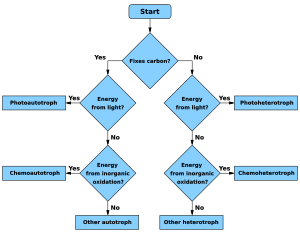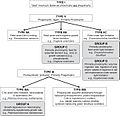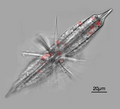Mixotroph facts for kids
A mixotroph is a living thing that can get its energy and food in more than one way. Imagine an organism that can act like a plant, making its own food from sunlight, and also like an animal, eating other tiny creatures! That's what a mixotroph does.

Most living things are either autotrophs or heterotrophs. Autotrophs, like plants, make their own food, usually using sunlight (this is called photosynthesis). Heterotrophs, like animals, get their food by eating other living things. Mixotrophs are special because they can do both! They might switch between these ways of getting food at different times.
Mixotrophs can be tiny single-celled organisms, like some bacteria or algae. They can also be larger living things, like some sea anemones or corals that have tiny algae living inside them.
Contents
How Mixotrophs Get Food
Mixotrophs are super flexible in how they find food. Here are some ways they combine different methods:
- Photosynthesis and Eating: Many mixotrophs can do photosynthesis (like plants) to make their own food using sunlight. But they can also hunt and eat other small organisms, like tiny bacteria or other single-celled creatures.
- Chemicals and Eating: Some mixotrophs can get energy from chemicals around them (this is called chemosynthesis). At the same time, they can also eat other living things.
- Living with Others: Some mixotrophs live in a special partnership called symbiosis. For example, tiny algae might live inside a larger animal, like a coral. The algae make food using sunlight, and the coral gets some of that food. The coral also catches food from the water.
This ability to use different food sources helps mixotrophs survive in many different places. If there isn't enough sunlight, they can eat. If there isn't enough food to eat, they can make their own.
Examples of Mixotrophs
There are many cool examples of mixotrophs in nature, especially among tiny organisms.
Single-celled Mixotrophs
Many single-celled organisms, called protists, are mixotrophs.
- Euglena: Euglena is a well-known example. It has chloroplasts, which are like tiny solar panels that allow it to make food from sunlight. But if there isn't enough light, Euglena can also swim around and absorb food from its surroundings or even eat tiny particles.
- Paramecium bursaria: This is a type of ciliate (a tiny organism with hair-like structures). It has tiny green algae called Zoochlorellae living inside it. The algae make food using sunlight, and the Paramecium gets some of that food. The Paramecium also uses its cilia to sweep food particles into its mouth.
Larger Mixotrophs
Some larger animals also show mixotrophic behavior, often through partnerships with tiny algae.
- Corals: Many corals have tiny algae called Zooxanthellae living inside their tissues. These algae perform photosynthesis and provide the coral with a lot of its energy. However, corals also use their tentacles to catch small food particles from the water.
- Sea Anemones: Some sea anemones, like Anthopleura xanthogrammica, get their green color from algae living inside them. These algae provide food from sunlight, while the anemone also catches and eats small fish or other prey.
Being a mixotroph is a clever way for organisms to adapt and survive in different environments, making them very important parts of many ecosystems.
Images for kids
-
Zooxanthellae are tiny algae that live inside hosts like coral and make food using sunlight.
-
A single-celled ciliate called Paramecium bursaria with green zoochlorellae living inside it.
-
Euglena mutabilis, a tiny organism that can do photosynthesis.
See also
 In Spanish: Mixotrofismo para niños
In Spanish: Mixotrofismo para niños









